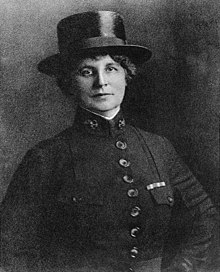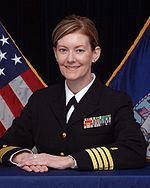United States Navy Nurse Corps
[3] However, it wasn't until 19 June 1861 that a Navy Department circular order finally established the designation of Nurse, to be filled by junior enlisted men.After the establishment of the Nurse Corps in 1908 by an Act of Congress, twenty women were selected as the first members and assigned to the Naval Medical School Hospital in Washington, D.C.In addition to normal hospital and clinic duties, the nurses were active in training natives in U.S. overseas possessions as well as the Navy's male enlisted medical personnel.Some of these teams were loaned to the United States Army during the intense ground offensives of 1918 and worked in difficult field conditions far removed from regular hospitals.Her citation reads, “For distinguished service and devotion to duty while serving at the Naval Base Hospital, Hampton Roads Virginia.During the epidemic of influenza, nurse Murphy worked day and night among the patients until stricken with the disease, as a result of which she lost her life.[8] It was also during this interwar period that paid retirement for longevity and disability was authorized as well as the extension of regular service to include Navy hospital ships.In addition to caring for Naval personnel at home and abroad, the corps responded to a number of civil disasters and assisted in the evacuation of dependents from war-torn China in 1937.[11] Navy nurses were on duty during the initial Japanese attack on Pearl Harbor, Kāneʻohe Bay, the Philippines, Guam, and aboard the Solace; they were vital in preventing further loss of life and limb.These outstanding nurses received advanced training in surgery, orthopedics, anesthesia, contagion, dietetics, physiotherapy, and psychiatry, the latter helping men understand and manage Post Traumatic Stress Syndrome (then known as shell-shock) and battlefield fatigue.Others were stationed in New Caledonia, the Solomons, New Zealand, Australia, New Guinea, Coral Sea, Savo, Samoa, Tarawa, Attu, Adak, Dutch Harbor, Kwajalein, Guam, Saipan, Tinian, Leyte, Samar, Iwo Jima, and Okinawa.In Europe, navy nurses served in both England and Italy and in North and South America at Trinidad, Panama, Puerto Rico, Bermuda, Brazil, and Newfoundland.The story of the USN Convalescent Hospital is not unlike a host of other facilities which were converted, including the Averell Harriman estate in the Bear Mountains of the Catskills and the Ahwahnee Hotel at Yosemite National Park.Aboard hospital ships, navy nurses followed the fleet in their assaults, and were eventually permitted to go to the beaches with the fighting men to pick up the wounded.After a certain number of transcontinental trips with wounded servicemen, the teams were sent to the Pacific to serve in the Naval Air Evacuation Service, the first arriving in Guam in early February 1945.These nurses served in hospitals as well as aboard the USS Haven and two other Haven-class ships, where almost 35 percent of battle casualties were admitted through September 1952.[21] Lt. Sarah Griffin Chapman, who had lost her lower left leg in an accident and retired prior to Korea, fought to be recalled to active duty so that she could teach other young amputees how to walk again.[21] In 1963, LT Bobbi Hovis volunteered to go to Vietnam, where she and four other nurses were tasked with converting a run-down Saigon apartment into the first US Navy Station Hospital—in four days.Operation Iraqi Freedom (OIF) 2006 in Al-Taqaddum Air Base (also known as Tammuz Airbase), Iraq, Active Duty Commander Lenora C. Langlais was the first African American female and first African American Nurse in the history of the U.S.Navy to receive the Purple Heart after being injured by a mortar bomb while serving as the Fleet Marine Force (FMF) Senior Combat Nurse with the 1st Marine Logistic Group (1st MLG) Surgical Shock Trauma Platoon (SSTP) combat hospital from Camp Pendleton United States Marine Corps.The Nurse Corps has a distinctive insignia of a single Oak Leaf, on one collar point, or in place of a line officer's star on shoulder boards.












United States Navythe first twentyCongressWilliam P.C. BartonNavy Departmenthospital corpsmanAmerican Civil Warhospital shipRed RoverMississippi RiverSisters of the Holy CrossSpanish–American WarSolaceThe Sacred TwentyJosephine Beatrice BowmanLenah H. Sutcliffe HigbeeEsther Voorhees HassonSara M. CoxWorld War IMayflowerDolphinReliefFirst World WarScotlandUnited States ArmyinfluenzaNavy Crosses1918 flu pandemicUSS HigbeearmisticeCommissioned officersWorld War IIhospital shipsUSS BenevolencePhyllis Mae DaileyEdith DeVoeHelen Fredericka Turnerattack on Pearl HarborKāneʻohe BayPhilippinesNew CaledoniaNew HebridesGuadalcanal Campaignthe SolomonsNew ZealandNew GuineaCoral SeaTarawaDutch HarborKwajaleinSaipanTinianIwo JimaOkinawaPearl Harborcontiguous United StatesTrinidadPanamaPuerto RicoBermudaBrazilNewfoundlandUSN Hospital San DiegoBethesdaMarylandUnion Pacific RailroadW. Averell HarrimanErnest HemingwayFor Whom the Bell TollsClark GableErrol FlynnClaudette ColbertBing CrosbyGary CooperCatskillsAhwahnee HotelYosemite National ParkUSS SolaceUSS ReliefBountifulSamaritanRefugeBenevolenceTranquilityConsolationReposeSanctuaryRescueLeona JacksonLaura CobbGoldia O'HaverAngels of BataanLos Baños internment campBronze Star MedalAnn Agnes BernatitusCorregidor IslandUSS SpearfishLegion of Meritflight nursesNaval Air Station AlamedaJane KendeighUSS HavenKorean WarYokosukaBronze StarSaigonPurple HeartUSS ReposeUSS Sanctuaryamphibious assaultUSNS MercyUSNS ComfortNavy Nurse CorpsSTA-21direct commissionFlight Nurse BadgeLenah Sutcliffe HigbeeMyn M. HoffmanSue S. DauserNellie Jane DeWittWinnie GibsonWilma Leona JacksonRuth Agatha HoughtonRuth Alice EricksonVeronica BulshefskiAlene B. Duerk